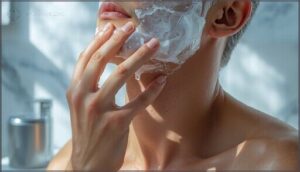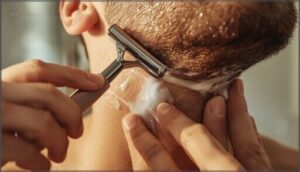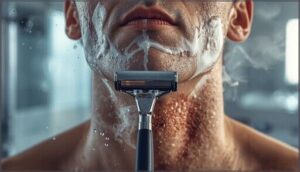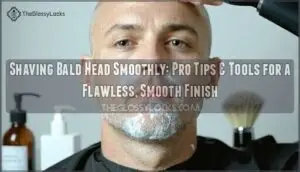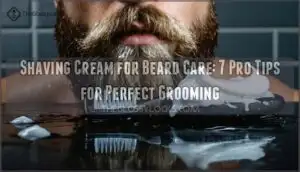This site is supported by our readers. We may earn a commission, at no cost to you, if you purchase through links.
Your first shave is a ritual, not a race. Most guys grab a razor the moment they spot peach fuzz, only to end up with a face full of razor burn, nicks that won’t stop bleeding, and regret.
The truth is, a smooth shave for beginners isn’t about having the fanciest gear or copying what you’ve seen in commercials. It’s about understanding your skin, respecting the grain of your facial hair, and building a technique that works with your face instead of against it.
Get the basics right from day one, and you’ll skip the common pitfalls that leave most beginners looking like they fought a cheese grater.
Table Of Contents
Key Takeaways
- Wait until your facial hair is thick, dark, and rough-textured before shaving—soft peach fuzz will just irritate your skin and doesn’t need a razor yet.
- Start with beginner-friendly tools like cartridge razors or electric trimmers, always shave after a warm shower with proper gel or cream, and use short strokes with the grain to avoid nicks and razor burn.
- Rinse your blade after every few strokes and never dry shave—skipping lubrication spikes skin irritation by 73% and triples your razor burn risk.
- Apply alcohol-free moisturizer immediately after shaving to lock in hydration and prevent irritation, then shave every 2-3 days at first to let your skin adapt before increasing frequency.
Signs You’re Ready to Shave
You don’t need permission to pick up a razor, but you do need to know when it’s actually time. Your body will send some pretty clear signals when facial hair moves from barely-there fuzz to something that needs attention.
Let’s look at the signs that tell you it’s time to start shaving.
Facial Hair is Thicker and Darker
You’ll know you’re ready when your facial hair starts looking noticeably thicker and darker. That’s hormonal influence kicking in—testosterone makes those hairs coarser and more visible. Darker hair perception means people notice it more, and so will you. If your upper lip or jawline suddenly looks shadowy instead of peach-fuzzy, it’s time to start thinking about shaving for beginners and building a shaving routine that works.
Understanding your facial hair growth can also help you prepare for shaving.
Uneven or Patchy Growth
Patchy beard growth is completely normal, especially between ages 14 and 21 when hormone balance is still leveling out. Up to 60% of guys see uneven facial hair during this stage—genetic factors and skin conditions play a role too.
Don’t stress if your cheeks look bare while your chin fills in. That’s your body’s natural timeline, and shaving for beginners means working with what you’ve got right now. Understanding facial hair changes can help you better manage your expectations.
Rough Texture Vs. Soft Texture
As your facial hair matures, texture tells you a lot. Soft, wispy hair doesn’t need shaving yet—it’ll just irritate your skin. But once it feels coarse and rough? That’s when razor selection matters and shave comfort becomes real.
Rough facial hair causes 33% more skin irritation if you skip proper hair softening and shaving techniques. Good skin care and a solid shaving routine prevent razor burn before it starts.
Visible Hair on Upper Lip, Chin, Jawline
Look in the mirror. If you see dark hair on your upper lip, chin, or jawline, it’s time. That’s your facial hair growth saying you’re ready for shaving for the first time.
About 50% of people deal with visible facial hair patterns here—sometimes from hormonal imbalance, sometimes just genetics. Either way, using the right shaving techniques and razor prevents skin irritation better than most hair removal methods.
Feeling Self-Conscious About Facial Hair
Self-doubt can hit hard when you notice facial hair. About 69% of teenage boys feel self-conscious about their appearance, including facial hair anxiety. Social media impact doubles that discomfort.
If body image issues around your upper lip or jawline are affecting your emotional wellbeing, that’s your sign.
Shaving for the first time builds shaving confidence. These male grooming tips and shaving safety practices help you take control.
Essential Tools for a Smooth Shave
You don’t need a whole arsenal to get started with shaving—just a few smart picks that’ll protect your skin and make the job easier. Getting the right tools now saves you from irritation, nicks, and that awkward patchy look nobody wants.
Here’s what you actually need in your shaving kit.
Types of Razors for Beginners
Choosing the right shaving tools can feel overwhelming when you’re just starting out. Here’s what you need to know about the main razor types:
- Cartridge razors dominate the market—they’re forgiving, easy to control, and have multiple blades with protective strips that minimize nicks.
- Disposable razors are affordable and perfect for experimenting without commitment.
- Electric shavers offer the gentlest learning curve with minimal irritation risk.
- Safety razors deliver close shaves but demand precise technique.
- Razor blades vary widely in sharpness and durability across all types.
Most beginners find cartridge razors or electric shavers easiest to master.
Shaving Gel Vs. Cream
You’ll notice two main products when shopping: shaving gel and shaving cream. Gels go on clear, letting you see exactly where your razor travels—perfect for precision around tricky spots. Creams create rich lather and deliver excellent moisture, especially if your skin runs dry or sensitive.
Both protect against nicks, but creams usually offer better aftershave comfort. Pick based on your skin type and whether you value visibility or hydration more.
Electric Trimmer for Initial Use
Starting with an electric trimmer takes the fear out of your first shave—nearly half of electric shaving users report less irritation than with blade razors. These tools rarely nick your skin and handle uneven growth without drama.
- Trimmer safety features like rounded blade tips protect beginners from cuts
- Blade maintenance stays simple—just clean debris after each use
- Grooming tips favor cordless models for easier handling and shave preparation
Moisturizer and Aftershave Options
Your freshly shaved skin needs immediate hydration—that’s non-negotiable. Aftershave balms deliver lotion-like moisture without the alcohol sting traditional splashes bring, while skin hydrators with ingredients like niacinamide or aloe vera calm irritation fast.
For sensitive skin, grab fragrance-free moisturizer types that won’t trigger redness. Alcohol-based aftershave lotion dries you out, so skip it until your skin toughens up through consistent skin care and better shaving tips.
Preparing Your Skin for Shaving
You can’t just pick up a razor and go to town on your face—trust me, your skin will hate you for it. The secret to a comfortable shave starts before the blade even touches your face.
Let’s walk through three simple prep steps that’ll save you from irritation, nicks, and that dreaded razor burn.
Hydrating and Softening Facial Hair
Think of your facial hair like a rope—dry and stiff, it’s tough to cut cleanly. Hydrating softens the texture and makes your blade glide easier.
Splash warm water on your face or shave right after a shower to prep your skin and hair. A little facial hair hydration goes a long way in preventing tugs, nicks, and irritation during shave preparation.
Cleansing and Exfoliating The Skin
Once your hair’s hydrated, wash your face with a gentle facial cleanser—Neutrogena or CeraVe work great for skin preparation. This removes oils and dirt that can clog your razor.
Next, exfoliate one to three times weekly with a scrub to lift hairs away from the skin. Studies show proper exfoliation techniques cut ingrown hairs by 34% and improve shave optimization.
Your skin care routine sets you up for success.
Importance of Shaving After a Shower
Now here’s the secret weapon for skin preparation: timing your shave right after your shower. Warm water softens facial hair by 40%, making it easier to cut and boosting razor efficiency.
You’ll see fewer nicks—rates drop from 8% to just 2%—and a 27% smoother result. This shave timing strategy reduces razor burn by 61% and cuts ingrown hairs by 36%, making your shaving routine far more comfortable.
Step-by-Step Shaving Techniques
You’ve got your tools ready and your skin prepped—now it’s time to actually shave. The technique matters more than you’d think, and a few simple steps can mean the difference between smooth skin and a face full of razor burn.
Let’s walk through the basics so your first shave (and every one after) goes exactly how it should.
Applying Shaving Gel Properly
You’ll want to lock down your gel application tips before picking up that razor. Start with damp skin—not soaking wet—and squeeze out just a quarter-sized dollop of shaving gel. Here’s what matters most:
- Massage it in for 30 seconds to soften every hair and create a protective barrier
- Spread it thin and even across your entire shave area for ideal razor glide techniques
- Wait 1-2 minutes before shaving to let the gel do its job
This simple shave optimization strategy cuts irritation markedly.
Shaving With The Grain
Now that your gel’s doing its job, map your grain before you even touch the razor. Run your hand across your face—down feels smooth, up feels rough. That’s your shave direction.
Hold the blade at a 30-degree angle, pull your skin taut along facial contours, and glide with the grain. This razor technique slashes irritation by nearly half and keeps those beginner nicks at bay.
Using Short, Gentle Strokes
Think of it this way: short, gentle strokes slash your cut risk by 40% and keep razor burn at bay. That’s the stroke technique pros swear by for shave safety and skin comfort.
- Move just 2–3 cm per pass for maximum razor control
- Lift and reposition instead of dragging the blade endlessly
- Ease up on pressure—the blade does the work
- Master these shaving techniques for beginners and you’ll own that smooth shave
Rinsing The Blade Frequently
After every few strokes, rinse your razor under warm running water—it’s the unsung hero of blade maintenance and razor hygiene. Clogged blades slash shave efficiency by 40% and spike skin irritation.
Rinsing keeps your razor care game tight, extends blade longevity, and delivers that smooth glide you’re after. Make it part of your shaving routine and watch your shaving technique level up instantly.
Avoiding Dry Shaving
Without proper lubrication, you’re inviting a world of hurt—dry shaving spikes skin irritation by 73% and triples your risk of razor burn. Always grab shaving cream or shaving gel before you touch that razor. A proper wet shave protects your facial care game and keeps aftershave lotion from stinging like crazy.
Here’s why dry shaving tanks your routine:
- Friction overload – Skin irritation jumps 33% without lubrication buffering the blade
- Cut city – Nicks increase 48% when you skip the shaving cream
- Moisture massacre – Skin loses 17% hydration instantly after a dry pass
- Ingrown nightmare – You’re 2.5 times more likely to get trapped hairs
- Long-term damage – Barrier breakdown hits 46% of habitual dry shavers
Post-Shave Care and Troubleshooting
You made it through the shave, but the job isn’t quite done yet. What you do in the next few minutes can make the difference between smooth, calm skin and a face that feels tight, stings, or breaks out.
Let’s walk through how to care for your skin post-shave and handle any little hiccups that come up.
Rinsing and Cooling The Skin
Right after you shave, splash your face with cool water—it helps close pores and cuts down redness by up to 38%. This simple step soothes skin irritation and balances your skin’s pH, which spikes after shaving.
Rinse your razor thoroughly between strokes too; it keeps the blade clean and prevents nicks. Cool water’s your secret weapon for calmer, healthier skin.
Moisturizing After Shaving
Your skin just lost a lot of moisture—shaving dries it out fast, often within 30 minutes. Skip moisturizer and you’re basically inviting irritation and tightness to the party. Pat your face dry, then apply a hydrating aftershave balm or lotion immediately. Alcohol-free options win here—they soothe instead of sting.
Here’s why post-shave care matters:
- Locks in skin hydration and prevents dryness
- Rebuilds your moisture barrier after razor contact
- Reduces redness and irritation instantly
- Makes future shaves smoother and less reactive
- Keeps skin healthy and prevents premature aging
Market data shows over 70% of guys now choose moisturizing products over old-school alcohol aftershaves—and for good reason. Consistent moisturizer use after every shave gives you cumulative benefits, making each shave feel better than the last.
Treating Cuts and Razor Bumps
Nicks happen—even pros get them. Rinse cuts with cold water immediately, then apply pressure with a clean tissue. A styptic pencil stops bleeding in seconds.
For razor bumps and ingrown hairs, use a gentle salicylic acid scrub and an alcohol-free aftershave to calm inflammation. Minor cuts heal within 3-7 days with proper wound care.
| Issue | Quick Fix |
|---|---|
| Fresh cuts | Cold water + styptic pencil |
| Razor bump prevention | Shave with grain, use sharp razor |
| Active bumps | Chemical exfoliant + soothing moisturizer |
| Skin infection risk | Keep tools clean, apply antibiotic cream |
| Ingrown hairs | Exfoliate regularly, avoid dry shaving |
Adjusting to Your Shaving Routine
Your skin needs time to adjust. Most beginners start shaving every 2-3 days—not daily—to let irritation heal.
Replace razor blades after 5-7 shaves to keep your technique sharp and prevent tugging. If redness or bumps keep showing up, dial back your shave frequency or switch to an electric trimmer.
Pay attention to what your skin’s telling you and tweak your routine accordingly.
Frequently Asked Questions (FAQs)
How often should beginners shave their face?
Start by shaving every two to three days—this gives your skin time to adapt while keeping stubble in check.
As your facial hair density increases and irritation decreases, you can gradually adjust your shaving frequency.
Can I share razors with family members?
Never share razors with family members. Sharing spreads bloodborne diseases like hepatitis B and HIV, plus skin infections and bacteria. Your razor is personal hygiene—keep it that way for safety.
What causes ingrown hairs and prevention methods?
Ingrown hairs happen when hair curls back into your skin after shaving. Prevent them by exfoliating regularly, shaving with the grain, using a sharp single-blade razor, and keeping your skin moisturized daily.
Should I shave against the grain eventually?
Think of your face as a fresh canvas—rushing bold strokes risks ruining it.
Most beginners shouldn’t shave against the grain for 4–6 weeks. Let your skin adapt first, then consider trying this closer shave technique cautiously.
How do I maintain and store razors?
Keep your razor dry between shaves—pat it down with a towel and store it outside the shower.
Clean weekly with rubbing alcohol to prevent bacteria buildup and rust.
Replace blades every five to seven uses.
Conclusion
Rome wasn’t built in a day, and neither is your shaving game. Your first smooth shave for beginners won’t be perfect—and that’s completely fine. What matters is that you’re building a foundation: proper prep, deliberate strokes, and post-shave care that protects your skin.
Each shave teaches you something new about your face. Stick with the process, skip the shortcuts, and you’ll develop a routine that feels natural, not stressful. Own it from the start.
- https://www.tiege.com/blogs/news/shave-before-or-after-shower-we-investigate-which-is-better-1
- https://www.dasitbarbershop.com/10-pre-shave-techniques-for-a-smoother-experience/
- https://shavercheck.com/pre-electric-shave-routine/
- https://pmc.ncbi.nlm.nih.gov/articles/PMC12194572/
- https://hoffmansgrooming.com/blogs/blog/shaving-cream-vs-shaving-soap




